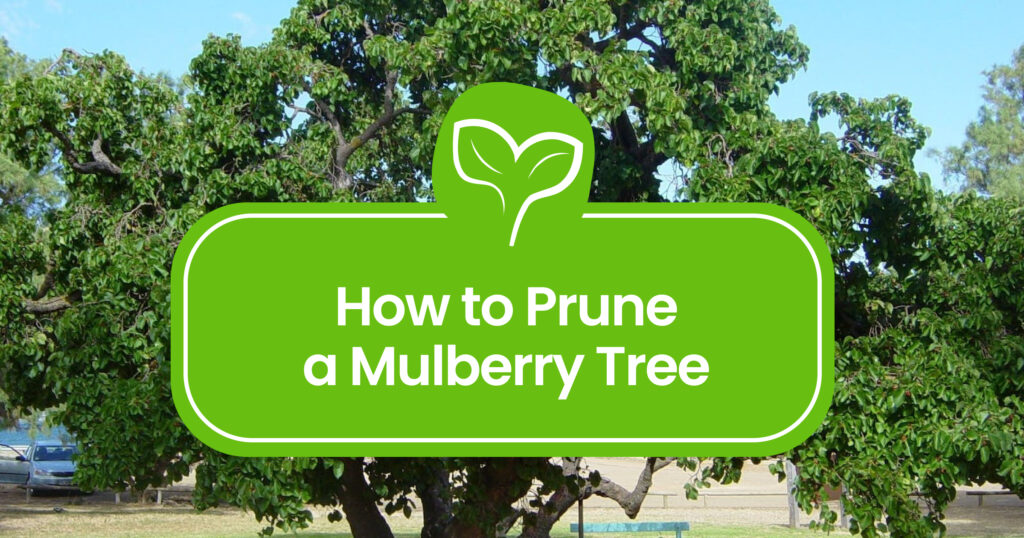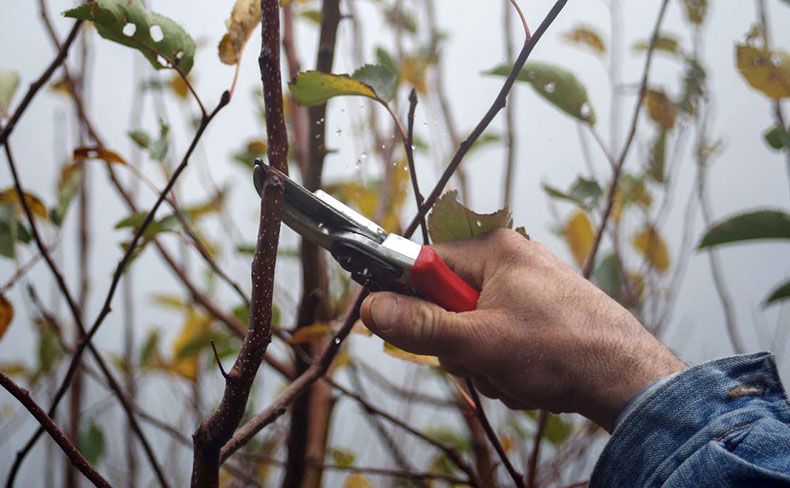Pruning a mulberry tree involves carefully trimming branches and removing dead or damaged parts to promote healthy growth and maintain an attractive shape. As a deciduous tree, mulberries benefit from annual pruning during the dormant season to stimulate new growth and enhance fruit production.
Pruning can also help manage the size of the tree and improve air circulation, leading to a reduced risk of diseases. Using sharp, clean tools and proper pruning techniques is important to avoid unnecessary damage. Regular pruning can ensure the longevity and vitality of your mulberry tree while maximizing its fruit yield.

Credit: plantpropagation.com
Understanding The Importance Of Pruning
Pruning is crucial to maintaining a mulberry tree’s health and productivity. By selectively removing certain branches and stems, gardeners can promote healthy growth, improve fruit production, and keep an appealing tree shape. Understanding the importance of pruning and properly executing this task can greatly benefit your mulberry tree’s overall well-being and maximize its potential. This article will explore why pruning a mulberry tree is essential, exploring how it can positively impact growth, fruit yield, and structural integrity.
Promoting Healthy Growth
Regular pruning plays a vital role in stimulating and enhancing the overall health of your mulberry tree. Removing dead or diseased branches prevents the spread of potential infections and allows the tree to direct nutrients and energy towards its healthy parts. Pruning also helps regulate the tree’s overall size, ensuring it does not grow too big and become unmanageable. When done correctly with proper techniques, pruning encourages the development of new, sturdy branches and stimulates the tree’s natural vigour, resulting in a robust and thriving mulberry tree.
Improving Fruit Production
One of the primary reasons for pruning a mulberry tree is to improve its fruit production. With regular pruning, you can strategically thin out overcrowded branches, allowing sunlight and air to penetrate the tree’s canopy. This increased exposure to sunlight, and improved air circulation fosters better fruit development by reducing disease risk and raising pollination opportunities. Furthermore, pruning excessively low or obstructive branches enables easier access for harvesting the ripened fruit. By pruning with precision and attending to the tree’s specific needs, you can significantly enhance the quality and quantity of the mulberries it produces.
Maintaining Tree Shape
Aesthetics are also an important consideration when pruning a mulberry tree. By regularly trimming and shaping the tree’s branches, you can maintain an attractive and well-balanced silhouette. Pruning can help prevent branches from growing excessively long or crossing over each other, improving the tree’s appearance and contributing to its structural integrity. Additionally, by removing branches that are weak or at risk of breaking, you are safeguarding the tree against potential damage during harsh weather conditions. By investing time and effort into maintaining the tree’s shape through prudent pruning practices, you can ensure that your mulberry tree remains an elegant and resilient addition to your garden.

Credit: www.starkbros.com
When To Prune A Mulberry Tree
Pruning a mulberry tree at the right time is crucial for its overall health and productivity. Understanding when to prune can ensure your mulberry tree thrives and yields an abundant harvest. There are two main periods when you can safely prune a mulberry tree: during dormancy and in early spring.
Pruning During Dormancy
During dormancy, which typically occurs in late winter or early spring, mulberry trees are dormant. This is the ideal time to prune them as they are not actively growing. Pruning during dormancy helps maintain the tree’s shape, remove dead or damaged branches, and promote new growth come spring.
To prune during dormancy:
- Start by inspecting the tree for diseased or broken branches. To prevent the spread of disease, these should be cut off completely.
- Trim any branches that are crossing or rubbing against each other. This will improve airflow and reduce the risk of infections.
- Identify any weak or spindly branches and remove them to allow the stronger branches to thrive.
- Selectively prune some of the older, larger branches back to the trunk to control the tree’s size. This will encourage new growth and maintain the tree’s size.
Pruning In Early Spring
Another suitable time to prune your mulberry tree is early spring, just before new growth starts. This is when the tree is still dormant but about to awaken for the growing season. Pruning at this time will stimulate growth, enhance the tree’s shape, and promote bountiful fruit production.
Here’s how to prune your mulberry tree in early spring:
- Remove dead, diseased, or broken branches by making clean cuts outside the collar. This will prevent unnecessary damage to the tree.
- Thin out the tree’s interior by cutting back branches growing towards the centre. This will improve sunlight penetration and air circulation, reducing the risk of fungal diseases.
- Shape the tree by selectively pruning branches that are growing in undesirable directions.
- Trim back any excessively long branches to maintain the overall balance and structure of the tree.
Remember, pruning a mulberry tree requires proper tools, such as sharp bypass pruners and a pruning saw, to ensure clean cuts and prevent tearing. By following these guidelines and pruning at the right time, you can help your mulberry tree thrive, bear delicious fruit, and enhance the beauty of your garden.
Step-by-step Guide To Pruning A Mulberry Tree
Welcome to our step-by-step guide on pruning a mulberry tree. Proper pruning is essential for the health and growth of your tree, allowing it to produce abundant fruit and maintain a sturdy structure. In this guide, we will walk you through the process of gathering the right tools, identifying diseased or damaged branches, removing suckers and water sprouts, thinning the canopy, pruning for shape and size, and applying proper pruning techniques. Let’s get started!
Gathering The Right Tools
Before you begin pruning your mulberry tree, gathering the right tools is essential to ensure a smooth and successful process. Prepare the following tools:
- Pruning shears
- Lopper
- Pole pruner (if needed for high branches)
- Saw (for larger branches)
- Gloves
Identifying Diseased Or Damaged Branches
Once your tools are ready, inspect the tree for any diseased or damaged branches. These branches can negatively impact the overall health of your mulberry tree. Look for signs of discolouration, fungi, or weak or brittle branches. Identifying and removing these branches will help prevent the spread of diseases and ensure the tree’s vitality.
Removing Suckers And Water Sprouts
Next, focus on removing suckers and water sprouts that may be growing along the base or trunk of your mulberry tree. These shoots often appear as unwanted growth and can drain essential nutrients from the main branches. Use your pruning shears or lopper to remove these growths carefully, ensuring a clean cut close to the base or trunk of the tree.
Thinning The Canopy
To maintain proper airflow and sunlight penetration, it’s important to thin the canopy of your mulberry tree. Identify branches crossing or rubbing against each other, as these can increase the risk of diseases and pests. Carefully remove one of the crossing branches, making a clean cut just outside the branch bark collar. Remember, aim to create a well-spaced and balanced canopy.
Pruning For Shape And Size
Pruning for shape and size lets you maintain your mulberry tree’s desired form and height. Trim any branches that appear excessively long or are growing in unwanted directions. Remember the tree’s natural growth habit as you prune, ensuring you maintain a balanced appearance.
Applying Proper Pruning Techniques
Lastly, it is crucial to apply proper pruning techniques throughout the process. Make clean cuts just outside the branch bark collar, promoting faster healing and reducing the risk of pathogens entering the tree. Avoid leaving stubs or cutting too close to the main trunk, harming the tree’s growth.
Remember to step back and assess your work regularly. Pruning is an art form that requires practice and patience. Don’t be afraid to seek guidance from a professional arborist if needed. Following this step-by-step guide, you’ll be on your way to a well-maintained and fruitful mulberry tree.
:strip_icc()/pruning-tree-limb-with-tree-saw-5197f15a-b271d97ff9dd46f0bbb74f6351b9ec88.jpg)
Credit: www.bhg.com
Frequently Asked Questions On Pruning A Mulberry Tree
How Do You Prune A Mulberry Tree?
To prune a mulberry tree, start by removing dead or diseased branches. Next, prune any crossing or rubbing branches and thin out the tree to improve airflow and light penetration. Finally, trim back long branches to maintain the desired shape and height.
When Is The Best Time To Prune A Mulberry Tree?
The best time to prune a mulberry tree is during its dormant season, typically in late winter or early spring before new growth begins. Pruning during this time encourages healthy growth and minimizes the risk of disease or insect infestation.
Can I Prune My Mulberry Tree In The Summer?
While it is generally advisable to prune mulberry trees during the dormant season, you can still prune in the summer if necessary. However, avoid heavy pruning during this time as it may stress the tree and affect its fruiting ability.
Instead, focus on removing any dead, damaged, or diseased branches.
Conclusion
Proper pruning is essential for a mulberry tree’s health and productivity. By following the right techniques and timing, you can ensure optimal growth and abundant fruit production. Regular pruning helps maintain the tree’s shape, removes dead or diseased branches, and promotes air circulation.
Remember to focus on selective pruning rather than excessive cutting, allowing the mulberry tree to thrive naturally. These tips will enable you to enjoy a flourishing and fruitful mulberry tree for years.

